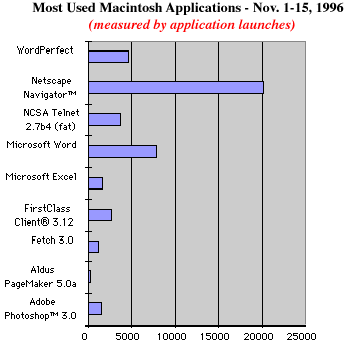Associate Vice President and Dean of Academic Computing, Indiana University
This paper is a report of key points made during the conference. The conference presentation was a shortened version of an HTML presentation, which is too lengthy to include here in full (the entire presentation consists of over 140 files). The presentation is rich in detail, containing many detailed tables, charts etc. By way of illustration, the main contents is shown below at figure 6. The complete presentation is available at url http://www.indiana.edu/~ucsdcas/jm
This paper describes in outline the approach taken to managing computing resources at Indiana University. The approach is based on resolute value chain analysis, constant monitoring of user perceptions, and resolute activity based costing.
Managers of academic computing resources are faced with four verities:
Despite this, there is little precedent for detailed financial analysis of the provision and use of academic computing. In the UK, Glasgow University is one of the few institutions to have examined these issues seriously.
Indiana is a state-wide university, with campuses at the locations shown in figure 1.

Figure 1: Indiana University Locations
University-wide, there are 92,000 students, 3,985 faculty and 13,190 staff. In Bloomington alone, the university has about 35,600 student, 1,520 are faculty and 4,890 staff.
The University Computing Services is about providing the right services to its thousands of customers, with the best possible mix of quality, cost and value.
Students pay annual fees of $100 (graduate students) and $200 (undergraduates) for access to the computing systems. This contributes to our provision of:
We have developed a pair of inclusive models to allow us to manage this situation. These models are:
This paper concentrates on the first of these.
The most fundamental decision has been to institute a form of Activity Based Costing (ABC). This allows us to derive a notion of "unit costs" for delivery of our services. To allow this, we have to analyse salary, equipment and other costs. In this way, we are able to report that in 1995/96, we provided 4.3 million seat-hours, at an average total cost of $0.57/hour plus "consultant" support of $0.20/hour. Other key statistics we monitor show us the cost of one e-mail message is $0.0017; and the cost of delivering one network packet is $0.0000001. Knowledge at this level of detail is an essential tool for us in negotiating contracts with providers such as telephone companies.
We conduct regular user surveys. This allows us to track users’ usage, and their perceptions on the quality of hardware, software, consultancy support and problem areas. By running the survey every year we can monitor changes year on year. Thus we monitor, for example, variations satisfaction with software. The two tables in figure 2 show the drop in satisfaction levels, particularly for graduate students, which we attribute to their higher expectations (complete details of the survey are in the HTML presentation).
|
Undergraduate | |||||
|
1993 - 1994 |
1995 - 1996 | ||||
|
Score |
% satisfied |
Respondents |
Score |
% satisfied |
Respondents |
|
4.2 |
100 |
116 |
4.3 |
99 |
100 |
|
Graduate | |||||
|
1993 - 1994 |
1995 - 1996 | ||||
|
Score |
% satisfied |
Respondents |
Score |
% satisfied |
Respondents |
|
4.1 |
94.8 |
250 |
4 |
84 |
76 |
Figure 2: Satisfaction with Software Provision
Users’ perceptions of their expertise is rising (from scores of 2.8 last year to 3.2 this year) along with their expectations; and 53.8% have a PC, most of whom have a modem.
We also monitor system usage using IT tools. This allows us to see, for example, the huge rise in the use of Netscape Navigator compared to the decline in the use of FTP (see "Fetch" in figure 3).

Figure 3: Software Package Usage
.
Our management imperative, of strategic cost management [56], stands on three "legs", as shown in figure 4.
|
| |||
|
|
Value Chain Analysis | ||
|
|
(linkages with suppliers and customers) | ||
|
Strategic Cost |
Strategic positioning Analysis | ||
|
Management
|
(cost leadership; product differentiation) | ||
|
|
Cost Driver Analysis | ||
|
|
(cost of poor quality; activity based costing) | ||
|
|
Figure 4: Management imperatives
These imperatives lead us to the idea of our management vision [57], shown in figure 5.
|
| |||
|
|
Learning and Growth Perspectives | ||
|
| |||
|
|
Internal Business Process Perspective | ||
|
Balanced | |||
|
Scorecard |
Customer Perspective | ||
|
| |||
|
|
Financial Perspective | ||
|
|
Figure 5: Management visions
We are constantly striving to reach the right compromises between these factors in order to get to a "balanced scorecard" with our $25,000,000 annual expenditure.
We are constantly honing all our processes. We take account both of requests from our staff and feedback from users (for example, the HTML presentation lists five actions taken in direct response to the survey).
One problem we have faced is the loss of trained staff. Loss of skills could be a serious problem for us, and we attacked the issue by addressing the "three T’s", namely
On the "toys" and tools front, we recognise that staff can be motivated as much by the resources they work with as by pay. We consider staff requests for equipment or software very favourably; in fact, almost any legitimate request is met. On the training front, we tripled our travel and training budgets so that they now make up about 6% of the total budget. This contributes to staff retention, as staff feel they are up to date with technology, as well as providing the direct benefit of growing expertise internally.
The level of support required by users continues to be a concern. We have found that a computerised Knowledge Base for users is a powerful tool which has actually reduced the volume of telephone and e-mail user contacts. This is not only powerful but effective, as our costings show the cost of one telephone contact is $4.51, and the cost of a Knowledge Base contact is only $0.26 (this is material in the context of nearly 1.5 million contacts per year).
For more information, refer:
|
SERVICES | |
|
Support and Education Networking Research and Instruction Information Systems Student Computing Public Computing Facilities: Costs Usage and Satisfaction: Consultants Hardware Software Mac Launches Problem Reports: By Equipment: By Site By Building By Status: JumpStart: Usage/Cost |
Mission Imperatives Mission Vision UCS User Survey Methodology Survey form Summary of results Text comments Actions taken in response to 1996 survey UCS Services FY 95-96 UCS Services FY 96-97 (projected) Glossary Computing Resources Old PCF Costs Old Consultants Old Hardware Old Software |
|
RESOURCES | |
|
Human UCS Staff Technical Network Data Centre |
Financial 95-96 Budget Budget Trend IUIS Usage Student Usage |
Figure 6: Contents of Presentation at url http://www.indiana.edu/~ucsdcas/jm
[55] This account was prepared for this report by The Marc Fresko Consultancy. It is based on notes taken during the presentation and the HTML pages used.
[56] Source: John K. Shank and Vijay Govindarajan, Strategic Cost Management , Free press, NY 1993.
[57] Source: Robert S. Kaplan and David P. Norton, The Balanced Scorecard , Harvard Business School Press, Boston, 1996.